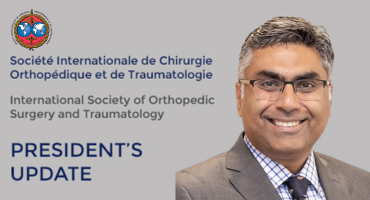
Update in Orthopaedics
Back to Basics: Management of Closed Midshaft Clavicle Fracture
Comparison of simple arm sling and figure of eight clavicular bandage for midshaft clavicular fractures. A randomised controlled study
A. Ersen, AC Atalar, F. Birisik et al. Bone and Joint J 2015;97-B:1562-5
Abstract
Only a few randomised, controlled studies have compared different non operative methods of treatment of midshaft fractures of the clavicle.
In this prospective, randomised controlled study of 60 participants (mean age 31.6 years; 15 to 75) we compared the broad arm sling with the figure of eight bandage for the treatment of midshaft clavicle fractures. Our outcome mesaures were pain, Constant and American Shoulder and Elbow Surgeons scores and radiological union.
The mean visual analogue scale (VAS) pain score on the first day after treatment was significantly higher (VAS 1 6.8; 4 to 9) in the figure of eight bandage group than the broad arm sling group (VAS 1 5.6; 3 to 8, p = 0.034). A mean shortening of 9 mm (3 to 17) was measured in the figure of eight bandage group, versus 7.5 mm (0 to 24) in the broad arm sling group (p=0.30)
The application of the figure of eight bandage is more difficult than of the broad arm sling, and patients experience more pain during the first day when treated with this option. We suggest the broad arm sling is preferable because of the reduction of early pain and ease of application.
SICOT Active Member and SICOT Newsletter Associate Editor – Seremban, Malaysia
In December 2014, the SICOT e-Newsletter published a scientific debate article on the management of closed midshaft clavicle fractures. I was writing the article on behalf of the non-operative treatment options and I noted that there was a lack of recent evidences for non-operative treatment. When compared to open reduction and internal fixation treatment, the number of evidences published were more recent which showed improved functional outcome when compared to non-operative treatment. Furthermore, the recent randomised trials were comparing non-operative versus operative treatment and none were comparing the various modalities of non-operative treatments.
Recently, this study was published on the above subject. I read it with interest and I found that the study conclusions on the use of non-operative treatment for closed, isolated midshaft clavicle fracture reassured me that the use of non-operative treatment is still applicable in our current practice.
I agree that the use of broad arm sling is more practical than the figure of 8 bandage. The study showed patients' tolerance to broad arm sling is better compared to the figure of 8 bandage. The rate of radiological union was within the expected norm. There was no case of non-union which was the main issue with non-operative treatment. However, the authors noted the small study population and high number of cases were undisplaced and minimally displaced which may explain the findings in their study.
The functional outcome at a mean follow-up of 8.3 months was satisfactory based on Constant and American Shoulder and Elbow scores. Their functional scores are comparable to other studies on clavicle fracture treated by operative treatment [1]. In my humble opinion, this study reaffirmed my conclusion that, in the right patient, non-operative treatment of closed midshaft clavicle fracture will yield similar results to operative treatment.
Reference:
- Robinson CM, Goudie EB, Murray IR et al. Open reduction and plate fixation versus non operative treatment for displaced midshaft clavicular fractures: a multicenter, randomised controlled trial. J Bone Joint Am 2013 4;95(17):1576-84














